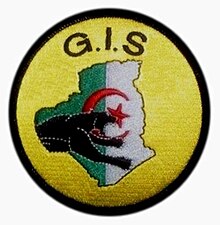Special_Intervention_Group
Special Intervention Group
Military unit
The Special Intervention Group (French: Groupe d'Intervention Spécial, GIS) is a special forces group created in Algeria[1][2] in 1987,[3] initially with 400 members.
This article needs additional citations for verification. (January 2013) |
| Special Intervention Group | |
|---|---|
 Official GIS insigna | |
| Active | 1987–2016 |
| Country | |
| Branch | Département du Renseignement et de la Sécurité |
| Type | Special Operations |
| Role | Counter-terrorism and Hostage Rescue |
| Size | ~400 operators |
| Garrison/HQ | Algiers, Algeria |
| Nickname(s) | Ninjas |
| Colors | Black |
| Mascot(s) | Black Panther |
| Engagements |
|
Since 1992, GIS forces have operated within the context of violent confrontation between the Algerian government and Islamic militants; major human rights violations against civilians have been alleged against both sides. A resulting arms embargo against Algeria initially prevented the GIS from obtaining equipment such as night-vision goggles typical for such units. However, after the September 11, 2001 attacks, western matériel vendors were allowed to sell equipment to Algeria in the name of the international War on Terrorism.
A sub-unit of the Département du Renseignement et de la Sécurité (DRS), it is responsible for counter-terrorism.[1] It is based in Algiers and has a base at Blida, 50 km (31 miles) from Algiers.[1] The Grouping of special intervention (GIS) made several elaborate training courses in various domains (assault, sniping, aircraft, bomb squad) to the Officers' training school of the special troops (EATS) in Algeria, without forgetting the training in the highly rated of the groups Alpha of Russia. The men of the GIS are trained in the Japanese martial arts Ju-Jitsu and the Korean martial arts Kuk Sool Won, but in a purely military aspect.
- Assault rifle
- Machine guns
- SMG
- Sniper rifle
- Shotguns
- Pistols
- Special Forces (Government) (Algeria). Jane’s Amphibious and Special Forces. 2 July 2012. Archived from the original on 16 February 2013. Retrieved 24 January 2013.
This African military article is a stub. You can help Wikipedia by expanding it. |